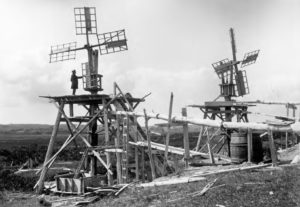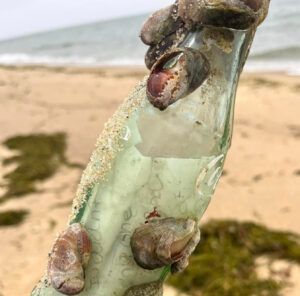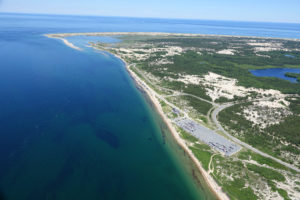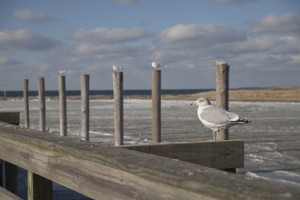
The ingenuity and tenacity of Cape Codders is evident in the development of the salt-making industry. Photo courtesy of Bob Kelley.
CHATHAM – In her 1957 hit “Old Cape Cod,” Patti Page extols the virtues of our salty air, but how often do we think about the value salt has had here, and its once vital role in the commercial fishing industry?
From the early days of the Massachusetts Bay Colony salt was critical for ensuring the stability of offshore catches, which in turn drove the economy.
“Plentiful quantities were required to preserve the fish caught by vessels that would go out to the Grand Banks for months at time,” says Yarmouth’s Bob Kelley, a tenth generation Cape Codder, member of the Dennis Historical Society and vice president of Yarmouth Historical Society. “They would catch the fish, gut them and pack them with salt before throwing them in the hold. An average 40-ton schooner would use 700 bushels of salt a year.”
New England’s salt supply was originally imported from England and Mediterranean countries, and eventually the British Caribbean Islands, which developed “works” to evaporate seawater and extract the valuable mineral.
“Salt making by solar evaporation really began here in 1775,” says Kelley. “The resource of salt water had always been here, but the colonists didn’t have the ability to extract it profitably.”
The cost of wood fuel needed to boil ocean water to distill salt was the problem.
“It cost more to burn the fires to get the salt than the salt was worth,” says Kelley.
It was cheaper to import through England’s vast network of colonies, territories and commodity exchanges.
But by 1775, the American colonies and England were on the brink of war, so the British government issued a much-despised salt tax and other interdictions that placed embargoes on imported goods and prohibited colonists from fishing off Nova Scotia.
“That is really what started things off,” says Kelley. “The king intended to starve them into submission, so it inspired Captain John Sears and others to begin this process.”
In the Quivet Neck section of what was then Yarmouth (now Dennis), Sears built a 10-foot by 100-foot shallow wooden container, and used buckets to fill it with seawater, which then evaporated in the sun. Solid salt remained, but not much: In 1776, the first full year of production, Sear’s salt vat only produced eight bushels of salt.
Sears, who had spent most of his life as a professional sea captain, caulked and improved his salt works and managed to increase production to 30 bushels the following year. Local neighbors were amused by “Sears’ Folly,” until November of 1778, when Sears salvaged a bilge pump from the wreck of the HMS Somerset III, a British man-o-war that sank off Provincetown (and had figured largely in the ongoing Revolutionary War.)
Sears put the recovered pump to work drawing seawater into the vat. His cousin Reuben Sears, a woodworker who had helped Sears with building the salt works, conceived of a rolling cover for the vat, which protected the seawater from being diluted when it rained.
“It became such an important industry in town,” says Kelley, “that when it was about to rain they would let school out so all the children could go to the salt works to help roll out the cover.”
When Nathaniel Freeman of Harwich suggested that Sears use a wind-driven pump for raising the water, the business flourished. These “pump mills” allowed cisterns beneath the windmills to capture thousands of gallons of water, which was then dispersed via wooden aqueducts into the vats, at just about a foot deep.
Sears obtained a patent for his invention in 1799, which he in turn granted to others, including Nathaniel Freeman, as a thank-you for his wind pump contribution.
“In that way,” says Kelley, “Freeman ended up with the rights to salt works in Harwich, Orleans and Chatham.”
Sears also deeded a large portion of his salt works in perpetuity to his sister Deborah Sears’ husband Christopher Crowell, who was his financier. “Sears gave back to a lot of people who helped him,” says Kelley.
By the early 1800s much of the Cape was operating successful salt works, with around 800 vat systems on the peninsula creating salt. And they were doing it year round. Summer was the season to produce common salt, but when the salt water became too cold in winter months, sodium sulphate (known as Glauber salt) would form instead. Cape Cod salt makers would sell their winter Glauber salt for other uses, including soap and dyes for textiles.
Sears’ design was not the only schematic for salt production.
“Hattil Killey invented one called ‘crane works’ which was like a checkerboard,” says Kelley, “with two covers connected diagonally with a fulcrum in the center and a metal rod into the ground. I believe it was an improved version, but the Sears model was less expensive to set up.”
Other Killeys, including brothers Seth and Zeno, worked with Abiel Akin and Isiah Crowell (himself a nephew of John Sears) to bring salt works to the Bass River area of Yarmouth.
“The works were located around the area where Ship Shops is now and extended above Main Street, half way up to Long Pond.” says Kelley. “My great, great grandfather David Kelley was still producing salt in Bass River village from 1885 through 1890. It was a local industry that lasted at least 100 years.”
Salt’s economic importance to Cape Cod was reflected in the ongoing battles between the northern industrial states and the rural south. The US government responded with varying levels of tariffs and embargoes, see-sawing between benefitting the North or placating the South. There were salt duties, subsidies, and the 1828 “Tariff of Abominations” (so called by the South) which was implemented to protect northern industry by taxing imported goods. By 1846, the pendulum had swung back again and the Walker Tariff reduced the rates of import duties.
“It was really the tariffs and the embargoes that regulated whether you could make a profit or not in producing salt,” says Kelley.
While various fluctuations on imports and exports wounded the industry, the discovery of salt deposits in upstate New York and ultimately the invention of refrigeration ended the salt works era on Cape Cod.
You can still relish local salt, but now as a cooking seasoning rather than a wholesale preservative. Businesses such as 1830 Sea Salt, Cape Cod Saltworks and the Wellfleet Sea Salt Company make it possible for you to sprinkle some locally harvested salt onto a nice filet, without needing to pack it into a barrel.
























